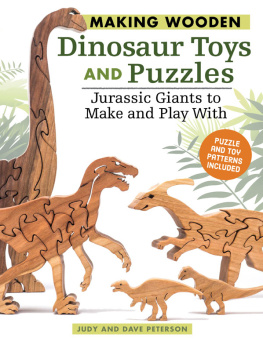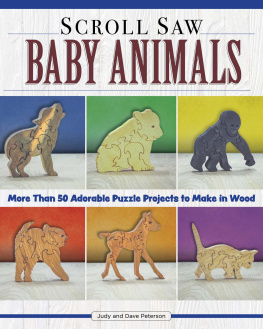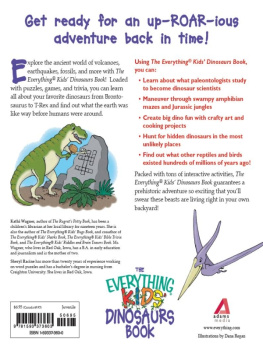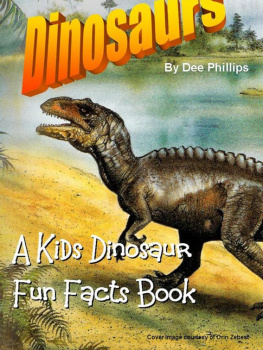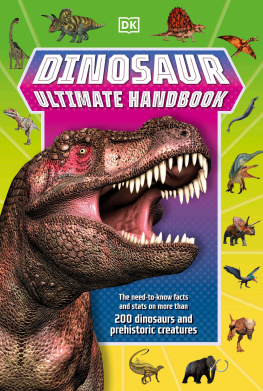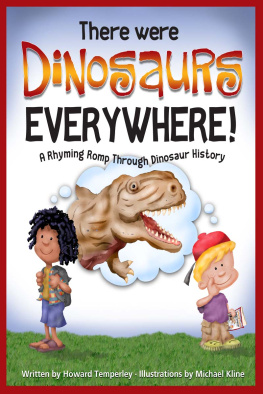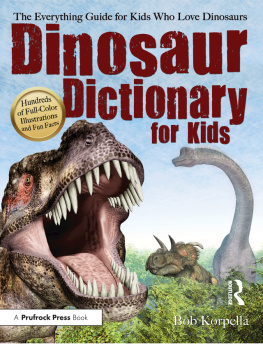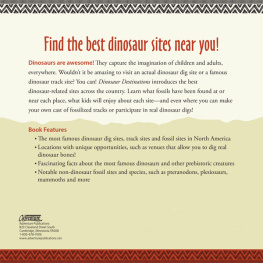Contents
Guide

INTRODUCTION
WHY DINOS?
I discovered at age 50 that I liked dinosaurs again. I had already designed quite a few puzzles and decided to try my hand at dinosaurs. While this book contains 63 patterns, there are only 27 different dinosaur species represented. Thats because I do more than one version of the better-known dinos. For example, there are five Tyrannosaurus Rex patterns (the Toy Rex, the easy Baby Rex, the intermediate 6-piece version, the advanced 10-piece version, plus the one that appears in a puzzle titled In the Cretaceous, the largest puzzle in the book).
How complicated should a puzzle be for a preschooler? This question is important to someone who makes puzzles for a living. Its important to someone whos making a puzzle for a child, too. The rule of thumb I use is age plus one piece. This varies with the child. The more dexterous the child, and/or the more experience the child has with puzzles, the more complicated the puzzle can be.
However, if youd like to create a piece that wont cause parents any anxiety, you can also cut out a toy version of the puzzle. The toy is almost exactly the same as the puzzle, it just doesnt break into pieces.
Many of the dinosaurs in this book are not well known. Thats why weve included a little information about each one on the patterns. This is intended to level the playing field for those of you who are making one or more of these puzzles for a child. Chances are good the child will already know about most of them.
WHY PUZZLES?
I like puzzles! These days when Im not making my own puzzles, Im likely to be doing someone elses. In 1989 my family and I made our annual trek to a nearby Renaissance Faire. As a souvenir I bought a five-piece rabbit puzzle. While it was attractive, it was not interlocking, so you really couldnt handle it.
The first thing I cut out when I brought home my first scroll sawa wonderful new toywas a three-piece rabbit. When I began designing my own puzzles, I decided all of them would be interlocking.
The puzzles in this book reflect that decision I made in 1990: all of these puzzles are interlocking. That means that once you have them in a standing position you can pick them up by any piece and turn them completely around without having them fall apart (but use caution with the Maiasaura). You can, that is, as long as you dont tip them!
WHY HARDWOODS?
When I was starting with my scroll saw, I tried cutting many different types of wood. I found I got much less chip-out using hardwoods. Hardwoods seem to be more uniformly dense. Another natural advantage of hardwoods is that they come in different colors, and so they dont need to be painted. Moreover, hardwoods look good with an oil finish.
When the idea of trying to sell my puzzles occurred to me, I tried painting them, but that took forever. Besides, Im really not good at painting. Im much better with a saw. This is the reason I cut the eyes, the mouth, and other details.
I have also found hardwoods to be very durable. Puzzles and toys cut from hardwoods will stand up to a lot of use, which is important whether you are cutting a puzzle or toy for a young child or an old child.

All of the puzzles in this book are interlocking. The puzzle pieces stay together when you pick up an assembled puzzle.
TABLE OF CONTENTS
Pattern
GETTING STARTED
SAFETY FIRST
It should come as no surprise that cutting thick wood generates a lot of sawdust. Breathing sawdust is not good for you. In my workshop, I have a dust collector and an air cleaner. The dust collector picks up large particles and a lot of the small ones. The air cleaner is mounted on the ceiling and removes a high percentage of the particles the dust collector misses. However, the air in the workshop will still have lots of tiny particles floating around. To ensure that Im breathing clean air, I wear a dust mask that uses replaceable filters. I strongly suggest you do the same.
Dust that accumulates on your piece as you work is also a safety hazard. Youll do a better job of cutting and be safer if your saw has a good dust blower. Allowing the dust blower to blow dust away from your cut line is much safer than trying to brush the dust away with your hand.
Eye protection is a must! I use my regular glasses, however, I have titanium frames and hardened lenses. When Im sanding, I wear side shields. These translucent plastic devices slide onto your frames and keep flying particles from hitting your eyes from the side. Whatever kind of eye protection you use in your workshop should include side shielding. If you dont need prescription lenses, use safety goggles.
Lighting is important, too. Make sure you have enough light in your workshop so you can see what youre doing. I have two swing-arm lamps mounted on my saw. These lamps come with clamps, and you can usually find somewhere to attach them if you dont have a mount for them on your saw. I find that I can cut longer with light coming from both sides. This eliminates shadows and lots of eye strain.
I also wear a hearing protector. If youre into serious woodworking you would be well advised to at least invest in a mask, eye protection, some type of hearing protection, and a dust collector.
Many finishes, including Danish oil, which I suggest for finishing dinosaur puzzles, have dangerous fumes. It is important to do your finishing in a well-ventilated area. It is equally important to let the paper towels dry thoroughly before discarding them. Never put them in a closed container or closed garbage bag before they are thoroughly dry, or you run the risk of starting a fire.
CHOOSING A BOARD
If your intent is to cut only one puzzle from a board, you need only choose a board wide enough and long enough to fit the puzzle. If you want to cut more than one puzzle from a board, choose a board wide enough to fit the largest puzzle.
Youll see references in this book to 4/4 hardwood. (When you speak it, say four quarter.) When a board is cut from a log, it is sized by the quarter inch. Usually by the time it appears in a rack at a lumberyard, a 4/4 has been planed to 13/16" (20mm) thick.
Because all my puzzles are designed to stand, the wider the board is, the more stable the puzzles will be. I usually use boards that are 15/16" (23mm) thick. I dont recommend using boards less than " (19mm) thick.
CHOOSING A BLADE
I recommend a #7 or #7 reverse-tooth blade to cut 4/4 hardwoods. The kerf is wide enough to allow the pieces to slide in and out easily. At the same time, the puzzles will hang together well. When using a thicker board use a #9 blade. Use a #5 blade for a board less than " (19mm) thick.

Careful planning will allow you to cut many dinosaur puzzles from one board.
SQUARING THE TABLE
Most scroll saws have an adjustable table that allows you to make cuts at different angles. There are times when you want the saw set at an angle, but most cutting is done with the blade perpendicular to the table. If the table is even slightly off square, the cuts will be angled, which will prevent the puzzle pieces from sliding together properly.

